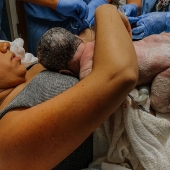Delayed cord clamping is a birth practice where the umbilical cord is not clamped or cut until after pulsations have ceased, or until after the placenta is delivered. A growing number of parents are choosing delayed cord clamping for their baby.
The timing of clamping the umbilical cord, and practices have a sizeable impact on the outcomes or mother and baby. Research has shown that when we delay cord clamping the neonate will receive up to 30% more of the fetal-placental blood volume than it would have with immediate cord clamping.
Benefits: The benefits of delayed cord clamping for the baby include a normal, healthy blood volume for the transition to life outside the womb; and a full count of red blood cells, stem cells and immune cells. For the mother, delayed clamping keeps the mother-baby unit intact and can prevent complications with delivering the placenta.
Risks of Immediate Cord Clamping:
For many decades, various studies have shown that immediate or early cord clamping disrupts normal physiology, anatomy and the birth process – it severs the baby from the still-functioning placenta and halts the circulation of blood.
Large studies have shown that immediate cord clamping can result in lower iron stores in the baby for up to 6 months after birth. While not all the implications of a reduced iron status are understood, iron deficiency in the first few months of life is associated with neurodevelopmental delay, which may be irreversible.
Early cord clamping can cause complications for the mother, too. There is some evidence that early clamping increases the risk of post-partum hemorrhage and retained placenta by engorging the placenta with the baby’s blood. This makes it harder for the uterus to contract and expel the placenta.
Risk of Delayed Cord Clamping:
Small studies have shown that delaying cord clamping increases the risk of jaundice. A study found that 3% of babies who experienced early cord clamping, compared to 5% of babies who experienced delayed cord clamping required treatment for jaundice.
About video: Penny Simkin demonstrates why the baby's umbilical cord should not be routinely clamped and cut immediately following birth.
- 28897 views













